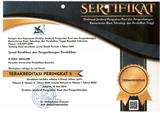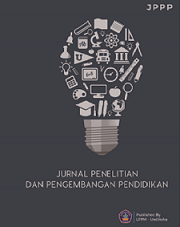Effectiveness of using Canva Application to Improve Learning Outcomes of Tenth Grades Students
DOI:
https://doi.org/10.23887/jppp.v7i3.67879Keywords:
Canva App, Learning Outcomes, Teaching FrenchAbstract
The influence of the use of supportive learning media in today's modern times is linked to low student achievement on French language learning, especially on French language learning material. The purpose of this research was to determine the effectiveness of using the Canva application on improving the French language learning outcomes of students at tenth grade. This research is quasi-experimental research. This study is used sampling technique which is simple random. The selection of sample members from the population is done randomly without considering the existing strata in the population. This research used two classes, namely X IPA class 1 as an experimental class (Implementation of Canva app) and X IPA class 4 as a control class using only Whatsapp. The data collection technique in this research was in the form of a test consisting of a pre-test and a post-test. Based on the t-test calculations that were performed in the experimental class and the control class, the sig. 000 then if the probability value is sig (two-sided) or (sig 0.05) then Ho is accepted. So, there is the effectiveness of using Canva app to increase the French language learning outcomes of tenth grade students.
References
Amri, Z. (2023). The use of the Canva application learning media in the Fiqh learning process. Jurnal Inovasi Dan Teknologi Pembelajaran, 10(1), 1–11. https://doi.org/10.17977/um031v10i12023p001. DOI: https://doi.org/10.17977/um031v10i12023p001
Amrina, A., Mudinillah, A., Hikmah, D., & Hamid, M. (2022). The Utilization of the Canva Application as A Media for Arabic Learning at MTs Negeri Sungai Jambu. Acitya: Journal of Teaching and Education, 4(2), 406–422. https://doi.org/10.30650/ajte.v4i2.3192. DOI: https://doi.org/10.30650/ajte.v4i2.3192
Andarwulan, T., Al Fajri, T. A., & Damayanti, G. (2021). Elementary teachers’ readiness toward the online learning policy in the new normal era during Covid-19. International Journal of Instruction, 14(3), 771–786. https://doi.org/10.29333/iji.2021.14345a. DOI: https://doi.org/10.29333/iji.2021.14345a
Andriyanto, O. D., Hardika, M., & Sukarman, S. (2022). Canva as a Media for Exploration of Indonesian Tourism Knowledge in BIPA Learning. Proceedings of the International Joint Conference on Arts and Humanities 2021 (IJCAH 2021), 618, 190–194. https://doi.org/10.2991/assehr.k.211223.034. DOI: https://doi.org/10.2991/assehr.k.211223.034
Ariesta, W., & Olifia, R. (2019). The effectiveness of e-learning media to improve natural science learning outcomes in elementary school. Journal of Education Research and Evaluation, 3(2), 88–94. https://doi.org/10.23887/jere.v3i2.17203. DOI: https://doi.org/10.23887/jere.v3i2.17203
Arsal, M., Danial, M., & Hala, Y. (2019). Pengembangan Media Pembelajaran E-Modul Materi Sistem Peredaran Darah pada Kelas XI MIPA SMAN 6 Barru. Prosiding Seminar Nasional Biologi VI Harmonisasi Pembelajaran Biologi Pada Era Revolusi 4.0, 434–442. http://eprints.unm.ac.id/12547/.
Astuti, A. P., Aziz, A., Sumarti, S. S., & Bharati, D. A. L. (2019). Preparing 21st Century Teachers: Implementation of 4C Character’s Pre-Service Teacher through Teaching Practice. Journal of Physics: Conference Series, 1233(1). https://doi.org/10.1088/1742-6596/1233/1/012109. DOI: https://doi.org/10.1088/1742-6596/1233/1/012109
Christiana, E., & Anwar, K. (2021). The Perception of Using Technology Canva Application as a Media for English Teacher Creating Media Virtual Teaching and English Learning in Loei Thailand. Journal of English Teaching, Literature, and Applied Linguistics, 5(1), 62. https://doi.org/10.30587/jetlal.v5i1.2253. DOI: https://doi.org/10.30587/jetlal.v5i1.2253
Churiyah, M., Basuki, A., Filianti, F., Sholikhan, S., & Fikri Akbar, M. (2022). Canva for Education as a learning tool for center of excellence Vocational School (SMK Pusat Keunggulan) Program to prepare competitive graduates in the field of creativity skills in the digital age. International Journal of Social Science Research and Review, 5(3), 226–234. https://doi.org/10.47814/ijssrr.v5i3.228. DOI: https://doi.org/10.47814/ijssrr.v5i3.228
Dewi, L. N. P. K., Astawan, I. G., & Suarjana, I. M. (2021). Belajar Ekosistem dengan Media Pembelajaran Audiovisual Berbasis Aplikasi Filmora untuk Siswa Sekolah Dasar. Jurnal Pedagogi Dan Pembelajaran, 4(3), 493–501. https://doi.org/10.23887/jp2.v4i2.37138. DOI: https://doi.org/10.23887/jp2.v4i2.37138
Fitria, T. N. (2022). Using Canva as media for English Language Teaching (ELT) in developing creativity for Informatics students’. ELT Echo : The Journal of English Language Teaching in Foreign Language Context, 7(1), 58–68. https://doi.org/10.24235/eltecho.v7i1.10789. DOI: https://doi.org/10.24235/eltecho.v7i1.10789
Hadi, M. S., Izzah, L., & Paulia, Q. (2021). Teaching writing through Canva application to enchance students’ writing performance. JOLLT Journal of Languages and Language Teaching, 9(2), 228–235. https://doi.org/https://doi.org/10.33394/jollt.v%vi%i.3533. DOI: https://doi.org/10.33394/jollt.v9i2.3533
Harahap, T., Husein, R., & Suroyo, S. (2021). Pengaruh Model Pembelajaran Contextual Teaching And Learning Terhadap Hasil Belajar Matematika Ditinjau Dari Berpikir Kritis. Journal of Education, Humaniora and Social Sciences (JEHSS, 3(3), 972–978. https://doi.org/10.34007/jehss.v3i3.462. DOI: https://doi.org/10.34007/jehss.v3i3.462
Indrayana, B., & Sadikin, A. (2020). Penerapan E-Learning Di Era Revolusi Industri 4.0 Untuk Menekan Penyebaran Covid-19. Indonesian Journal of Sport Science and Coaching, 2(1), 46–55. https://doi.org/10.22437/ijssc.v2i1.9847. DOI: https://doi.org/10.22437/ijssc.v2i1.9847
Irving, K. E. (2006). The impact of technology on the 21st century. Teaching Science in the 21st Century, March 1981, 3–19. https://cmapsconverted.ihmc.us/rid=1JVHR9TKT-1VMCFZP-SHW/21st century.pdf.
Kurniawan, E., Nizzam, M., Fatikh, M. A., & Rofiq, M. H. (2022). Pengaruh Penggunaan Media Audio Visual Terhadap Hasil Belajar Kosa Kata Bahasa Inggris Siswa Kelas II MI Dwi Dasa Warsa. Attadrib: Jurnal Pendidikan Guru Madrasah Ibtidaiyah, 5(1), 27–38. https://doi.org/10.54069/attadrib.v5i1.226. DOI: https://doi.org/10.54069/attadrib.v5i1.226
Lara, M. D. M., & Pedrosa, A. V. C. (2017). Teacher perspectives on clil implementation: a within-group comparison of key variables. Porta Linguarum: Revista Internacional de Didáctica de Las Lenguas Extranjeras, 29, 159–180. https://doi.org/10.30827/Digibug.54032. DOI: https://doi.org/10.30827/Digibug.54032
Larasati, M., & Rustandi, A. (2022). Empowering student’s creative writing ability by using Canva (A case study research in one junior high school in Ciamis). JEEP: Journal of English Education Program, 9(2), 101–110. https://doi.org/10.25157/(jeep).v9i2.8548. DOI: https://doi.org/10.25157/(jeep).v9i2.8548
Lastari, D. S., & Silvana, R. (2020). the Effects of Summarizing Using Infographics on Efl Learners’ Reading Comprehension. Globish: An English-Indonesian Journal for English, Education, and Culture, 9(2), 128. https://doi.org/10.31000/globish.v9i2.2707. DOI: https://doi.org/10.31000/globish.v9i2.2707
Madadizadeh, F. (2022). A tutorial on Quasi-experimental designs. Journal of Community Health Research, 11(1), 3–4. https://iranjournals.nlai.ir/bitstream/handle/123456789/916068/B056CA7D2AA0554C0E7FEFF379D08F6C.pdf?sequence=-1.
Melinia, S., & Nugroho, N. (2022). Creating A video using Canva application as an English learning media of recount text material. Journal of English Education, 2(2), 118–129. https://doi.org/https://doi.org/10.30998/jedu.v2i2.6644. DOI: https://doi.org/10.30998/jedu.v2i2.6644
Monoarfa, M., & Haling, A. (2021). Pengembangan Media Pembelajaran Canva dalam Meningkatkan Kompetensi Guru. Seminar Nasional Hasil Pengabdian, 1085–1092. https://ojs.unm.ac.id/semnaslpm/article/download/26259/13283.
Munir, N. S., Gani, H. A., & Mappalotteng, A. M. (2022). Pengaruh Media Pembelajaran E-Learning, Gaya Belajar, Dan Motivasi Belajar Terhadap Hasil Belajar Siswa Pada Mata Pelajaran Simulasi Dan Komunikasi Digital Kelas X Di SMK Negeri 2 Pinrang. UNM of Journal Technologycal and Vocational, 6(1), 25–34. https://doi.org/10.47750/pegegog.14.01.39. DOI: https://doi.org/10.26858/ujtv.v6i1.34285
Purwanto, A. (2021). Teacher Readiness in the Era of Revolution Industry 4.0 to Face Millennial Student. Brila: Journal of Foreign Language Education, 1(1), 1–8. http://journal.unj.ac.id/unj/index.php/brila/article/view/19854.
Putrawangsa, S., & Hasanah, U. (2018). Integrasi teknologi digital dalam pembelajaran di era industri 4.0. Jurnal Tatsqif, 16(1), 42–54. https://doi.org/10.20414/jtq.v16i1.203. DOI: https://doi.org/10.20414/jtq.v16i1.203
Rahmatullah, I. (2020). Media Pembelajaran Audio Visual Berbasis Aplikasi Canva. Jurnal Pendidikan Ekonomi Undiksha, 319. https://doi.org/10.23887/jjpe.v12i2.30179.
Rahmawati, F., & Atmojo, I. R. W. (2021). Analisis Media Digital Video Pembelajaran Abad 21 Menggunakan Aplikasi Canva Pada Pembelajaran IPA. Jurnal Basicedu, 5(6), 6271–6279. https://doi.org/10.31004/basicedu.v5i6.1717. DOI: https://doi.org/10.31004/basicedu.v5i6.1717
Salam, M. Y., & Mudinillah, A. (2021). Canva Application Development for Distance Learning on Arabic Language Learning in MTs Thawalib Tanjung Limau Tanah Datar. Jurnal Teknologi Pendidikan, 23(2), 101–111. https://doi.org/10.21009/jtp.v23i2.20650. DOI: https://doi.org/10.21009/jtp.v23i2.20650
Schunk, D. H., & DiBenedetto, M. K. (2020). Motivation and social cognitive theory. Contemporary Educational Psychology, 60, 101832. https://doi.org/10.4103/0019-5154.182410. DOI: https://doi.org/10.1016/j.cedpsych.2019.101832
Septianto, W., & Hasan, M. K. U. (2017). Efektivitas Penggunaan Media Pembelajaran Elektronik Interaktif Pada Hasil Belajar Siswa. Jurnal Pendidikan Vokasional Teknik Mesin, 5(3), 175–181. https://doi.org/10.21831/teknik%20mesin.v5i3.7107.
Setiawan, E. P. (2019). Analisis muatan literasi statistika dalam buku teks matematika Kurikulum 2013. Pythagoras: Jurnal Pendidikan Matematika, 14(2), 163–177. https://doi.org/10.21831/pg.v14i2.28558. DOI: https://doi.org/10.21831/pg.v14i2.28558
Thyer, B. A. (2012). Quasi-Experimental Research Design. Oxford University Press, Inc. DOI: https://doi.org/10.1093/acprof:oso/9780195387384.001.0001
Wijayanti, E. (2022). Teaching English by Using Canva : Students ’ and Lecturers ’ Voice. ENGLISH FRANCA: Academic Journal of English Language and Education, 6(2), 1–9. https://doi.org/10.29240/ef.v6i2.5709. DOI: https://doi.org/10.29240/ef.v6i2.5709
Winarno, A., Fedin, M. Y. A., & Salleh, N. H. M. (2022). the Effect of Technological Literacy, Learning Facility, and Family Environment on Students’ Learning Motivation. Jurnal Pendidikan: Teori, Penelitian, Dan Pengembangan, 7(7), 246. https://doi.org/10.17977/jptpp.v7i7.15404. DOI: https://doi.org/10.17977/jptpp.v7i7.15404
Yundayani, A., Susilawati, & Chairunnisa. (2019). Investigating the effect of Canva on students’ writing skills. Journal of English Education, 7(2), 169–176. https://doi.org/10.25134/erjee.v7i2.1800.
Downloads
Published
How to Cite
Issue
Section
License
Copyright (c) 2023 Junita Friska, Isda Pramuaniati, Mahriyuni

This work is licensed under a Creative Commons Attribution-ShareAlike 4.0 International License.
Authors who publish with the Jurnal Penelitian dan Pengembangan Pendidikan agree to the following terms:
- Authors retain copyright and grant the journal the right of first publication with the work simultaneously licensed under a Creative Commons Attribution License (CC BY-SA 4.0) that allows others to share the work with an acknowledgment of the work's authorship and initial publication in this journal.
- Authors are able to enter into separate, additional contractual arrangements for the non-exclusive distribution of the journal's published version of the work (e.g., post it to an institutional repository or publish it in a book), with an acknowledgment of its initial publication in this journal.
- Authors are permitted and encouraged to post their work online (e.g., in institutional repositories or on their website) prior to and during the submission process, as it can lead to productive exchanges, as well as earlier and greater citation of published work. (See The Effect of Open Access)







